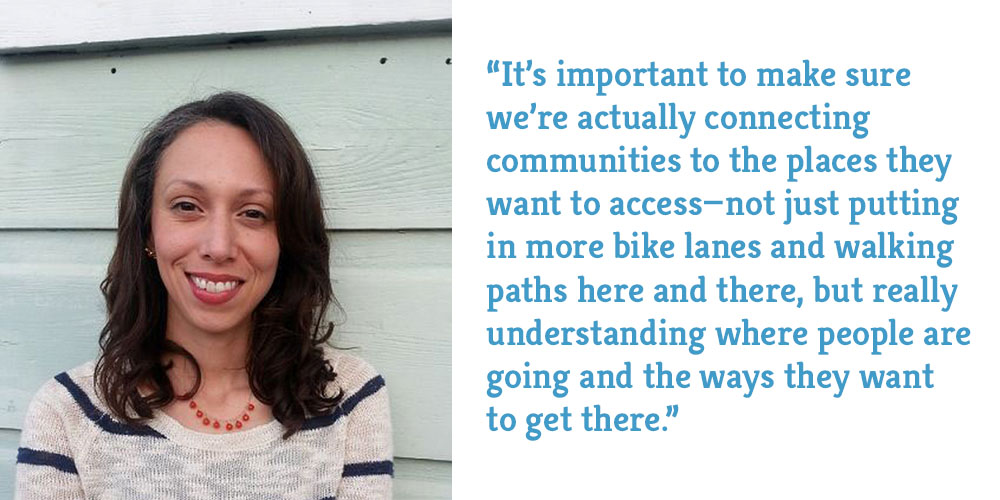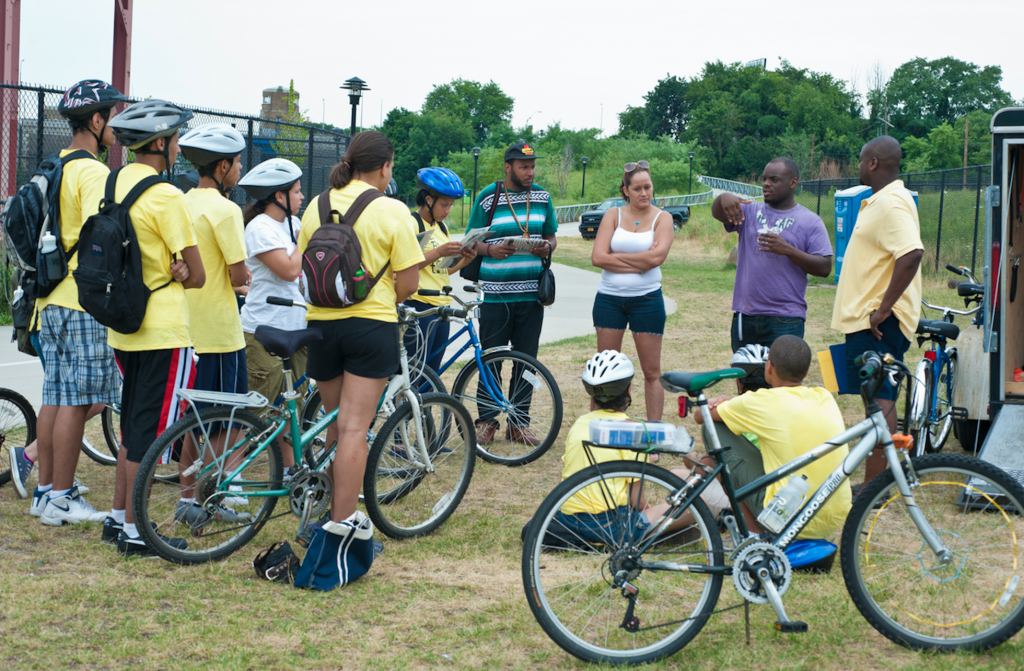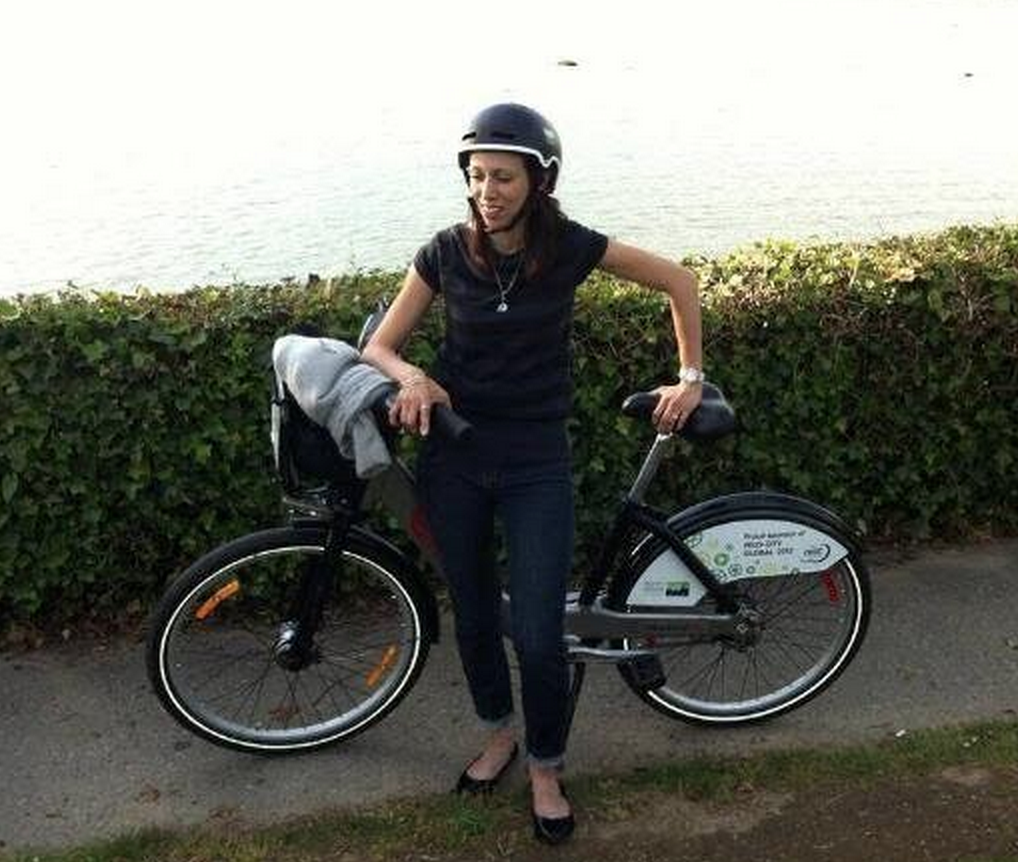Our On the Ground conference with Grassroots Grantmakers is just around the corner, and we couldn’t be more excited about how this convening of grantmakers and citizen leaders is shaping up. Helping us kick off the event on the first evening will be Naomi Doerner. Naomi is an urban planning professional with over a decade of experience in engaging communities and growing coalitions. She specializes in sustainable and active transportation planning and advocacy. Lucky for us, Naomi also recently added “ioby Board Member” to her CV.
We talked to Naomi about her work building support for walking, bicycling, and transit use; how she began riding a bike; and why she’s excited to help push cycling beyond “Mr. Spandex.”

ioby: Why is cycling important—to you, and for communities?
Naomi: I’m a strong believer in mobility, ease, and access to places you need and want to go. For me, biking is usually the easiest way to accomplish all of those. It’s really fun and cheap, and it doesn’t take up a ton of space. Plus I love the idea of the self-determined journey.
ioby: What initially led you to focus on cycling ?
Naomi: When I was a kid, my mom was young and undocumented and worked a number of jobs. We didn’t have a car early on, which even then I could see limited her ability to get places. We’d walk and take the bus and eventually get where we needed to go—school, work, the library—though all of that travel time definitely limited how much she could be at home with me. Her ability to get around at all, though, did certainly aid her in taking that next, higher paying job that allowed us to get ahead. So, that’s how I know it’s so critical for cities to promote mobility options—walking, bicycling, and transit: because many people don’t have other good options, and it makes for a much more connected and accomplished city when more people have options; choices to get around. I happen to enjoy moving on two wheels.
ioby: When did you start biking?
Naomi: I didn’t start biking in everyday life until I was an adult. I had a bike when I was a child, but bicycling wasn’t really a thing in my community, culturally. When my mom discovered that I was biking in my late 20s in New York City, she was a little scared. In grad school, I started going out with a group of girlfriends—we were this pack of women of color biking together. The community and camaraderie I felt then made me so much more comfortable, and really got me hooked.
So that’s how I got into biking for myself, but the equity piece was always there; I was always a proponent of mobility. In grad school, I studied how transportation informs equity, and afterward, I worked in the public and private sectors on sustainable transportation projects and engaging people in the planning process. In a lot of the communities I worked in, I noticed the people weren’t the ones making the decisions, and the decisions makers weren’t representative of the communities. It was odd and didn’t sit right with me: here we were making all these recommendations involving communities and their public spaces—streets—and how they access public transportation, and the processes weren’t really representative! Motivated by that, some of my bicycle riding partners and I co-founded Velo City, an education initiative that empowers teens from underserved NYC neighborhoods to be ambassadors of social change in their areas. It was our contribution to shifting the paradigm by saying, “We’re professional planners and women of color: What would it mean for young people of color to identify with us? What changes would they like to see?” And we decided to create a mobile exploration of these questions; we did it all by bike. It was a real blend of education and advocacy.

ioby: In your eyes, what would the perfect city or town look like from a bicycling perspective?
Naomi: I’m not really one for utopias; I think complexities are what make places interesting. That said, I would love to see mobility be a higher priority. A mix of options like bus rapid transit or bike share or more pedestrianized corridors.
It’s important to make sure we’re actually connecting communities to the places they want to access—not just putting in more bike lanes and walking paths here and there, but really understanding where people are going and the ways they want to get there. The more connections people are able to make—through better walking and biking and transit infrastructure, through safer streets for all people, through accessible open spaces people can enjoy—the better. Making these things for the people who are already in the neighborhood, as well as trying to attract newcomers to it, is also important. That’s a critical balance. We need to do it for equitability as much as for economic prosperity.

ioby: Can you tell us about a favorite project or initiative you’ve worked on, and why it was so memorable?
Naomi: Other than Velo City, NOLA Women on Bikes was a big one for me. The idea came about when I saw a mini-grant opportunity from the League of American Bicyclists to address the gender gap in cycling. Our first big success was with teaching young women of color bike repair skills at local bike shops. There aren’t many women in bike professions in New Orleans, and even fewer women of color—which is crazy in a city that’s over half African American! So we wanted to cultivate greater interest among these women in all things bike-related—both for their self-sufficiency and their future employment options.
ioby: How have you seen urban cycling change since you’ve been on the scene?
Naomi: It’s really cool. As a planner who looks at cities as a hobby, it’s really fascinating to see bicycling become more than a conversation about infrastructure. For a long time in the planning community, it’s been most common for technical planners to talk about the technical infrastructure aspects of bike growth and amenities. So it’s been wonderfully interesting to see the focus shift to being about livability and people—not about “that protected bike lane” so much as what will make communities safer, healthier, happier. That’s a cultural shift that’s huge and exciting.
There’s acknowledgement, too, that cycling is not just for your hardcore messenger type anymore, or for Mr. Spandex. There are all different kinds of riders! Moms taking kids to school, young people popping wheelies and doing BMX tricks, young professionals riding their Linuses to work… People are seeing that it’s really about mobility, across the board.

ioby: What’s one big thing you’ve learned from your work in the past decade?
Naomi: Since I came to this work knowing transportation to be a major rung in the ladder of opportunity, it’s been really interesting for me to learn that the biking and walking movements have been most strongly growing out of the environmental movement of the ‘70s. I don’t have that background—I have the social equity background. So now, seeing huge changes in thought reverberating throughout these parallel movements and bringing them closer together is really exciting. The same thing is happening with the bicycling and pedestrian movements, which at times have been at odds, but now we’re seeing them aligning better.
There have always been great synergies and power between all of these movements, but I think now we’re seeing the coalitions coming together. It’s refreshing and it feels better; it makes for stronger organizations.
ioby: Earlier this year, you joined the Alliance for Biking and Walking as their Advocacy and Membership Manager. What are you most excited about accomplishing there?
Naomi: For one, I really love our team. They’re fun, passionate, they contribute in mindful ways… And then I get to work with all these amazing individual advocates who are on the ground, in their communities every day, writing letters, going to City Hall… It’s really inspiring.
The other thing I’m most excited about is that moving forward, we’re going to be doing more with our community planning process. I think it will really help us build the capacities of the on-the-ground biking and walking advocates we support. We have some really good ideas about how we can better support our activists, with more leadership development, more conversations, etc.
ioby: What led you to join ioby’s Board of Directors?
Naomi: Having been a person with an idea and thinking, “Oh, this is kind of an awesome but crazy idea!” (In this case, the Bikesplorations project, which might have been ioby’s first bike project!) But I didn’t know exactly what to do about it; I just knew I needed money and resources. So finding the amazing community and guidance ioby offers was so vital. They gave me support and helped me get money, and our relationship has grown over time.
I’ve recommended ioby to so many people with ideas, and it’s always turned out well, because it’s not just about the money—it’s about the education and one-on-one attention that comes along with it: the knowledge of how to scale up, the network that’s there for you… When I got to the Alliance, I knew I’d be better able to contribute and guide growth here based on my experiences with ioby. So I guess I just wanted to help them out and become an even bigger part of what they do.